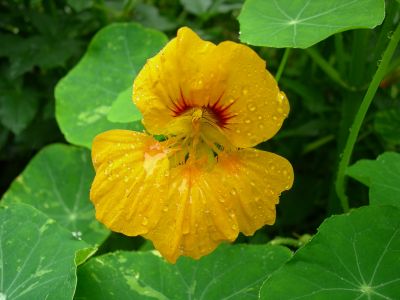Garden Nasturtium - Tropaeolum Majus

Common Names: Garden Nasturtium, Indian Cress, Common Nasturtium, Monks Cress, Kapuzinerkresse (German, international), Tropaeolum majus, Nasturtium, Capucine (French, international), Latin: Tropaeolum majus, origin: Peru, Ecuador, Colombia
Latin Name: Tropaeolum Majus
Origin: Africa, Asia, Australia, Europe, South America, North America
Short Introduction
The Garden Nasturtium is sensitive to frost and should be sown in May. It thrives best in full sun or partial shade and prefers moist, moderately fertilized soil. It does not become invasive in temperate Central European climates.
Detailed Description
An old saying goes: With nasturtium ointment, even baldness is past!
Botanical Information
Garden Nasturtium is an annual herb in Central European climates. It is distinguished by its creeping, sprawling stems that can reach up to 3 meters in length. Its eye-catching solitary orange, five-petaled flowers rise from a spread of smooth, shield-shaped leaves.
Origin and Distribution
The native lands of Garden Nasturtium are South American countries—Ecuador, Peru, and Colombia. At the end of the 17th century, this stunning flower captivated European explorers and was brought to the continent for decorative purposes. Given its preference for subtropical and temperate climates, it soon adapted to other corners of the globe as well—such as China and Australia.
Usage / Dosage
European Union regulations (EC) No. 1924/2006 on nutrition and health claims prevent us from describing the effects of this herb on your health. Please consult freely available sources online or in reputable literature if you are interested in its properties.
Active Compounds
The plant contains a compound called glucotropaeolin, which enzymatically converts in the body into the antibiotic-active benzyl isothiocyanate. Other key constituents include vitamin C, iron, and potassium.
Traditional Dosage
Garden Nasturtium is typically used 3 times a day at 8-hour intervals—a tea is made from one teaspoon of crushed seeds steeped for 15 minutes in 200 ml of water. It is recommended to take a week-long break after three weeks of use. Some sources recommend uninterrupted use.


